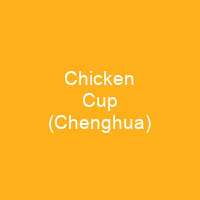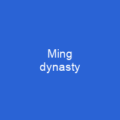A Chicken Cup is a bowl-shaped vessel made of Chinese porcelain painted in the doucai technique. Chicken cups were created during the Ming dynasty during the Chenghua Emperor’s reign in China. The cups originally functioned as a vessel to drink wine from. Imitations of chicken cups as well as other blue and white Jingdezhen wares were prominent in Southern Chinese kilns.
About Chicken Cup (Chenghua) in brief

The high temperatures also caused the content of iron and calcium oxide present in the glaze to become clear and soft sheen which led to the cup’s characteristic clear andsoft sheen. A rooster and a hen which feed their young chick, as they grub for worms and stretch out their wings, are interpreted as representing core dynastic Chinese values, such as continuing the family line and nurturing the young. Several references within Chinese literature describe the fortunes allocated by nobles and emperors in order to obtain chicken cups in the 17th century, including the Kangxi Emperor and the Wanli Emperor. The cup was sought out after by Ming, Qing and Wanli emperors, and other Chinese literati collectors and connoisseurs in China, and was reported to have had a rare chicken cup stolen from his dining table. It is believed that the cups were stolen from the kilns by officials within the Imperial palace where records of cups stolen from kilns exist. These cups were also subject to corruption amongst officials in the imperial palace where they were sold as replicas of the original cups.
You want to know more about Chicken Cup (Chenghua)?
This page is based on the article Chicken Cup (Chenghua) published in Wikipedia (as of Dec. 18, 2020) and was automatically summarized using artificial intelligence.







